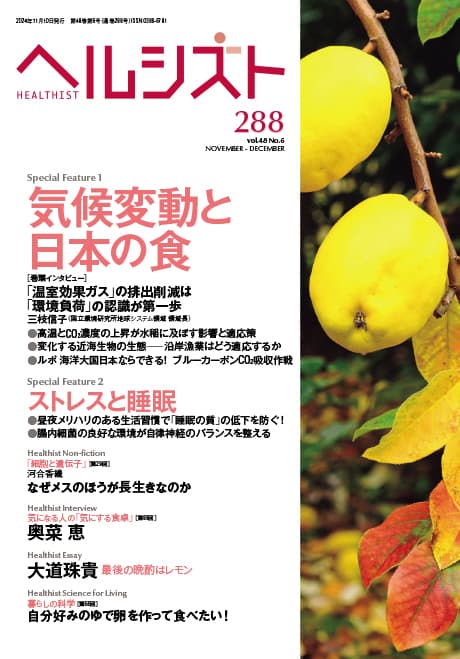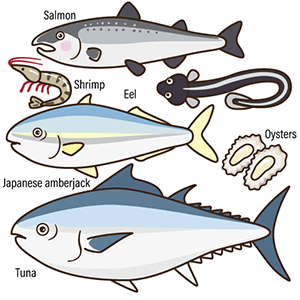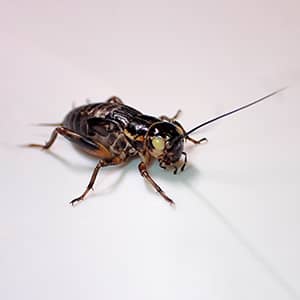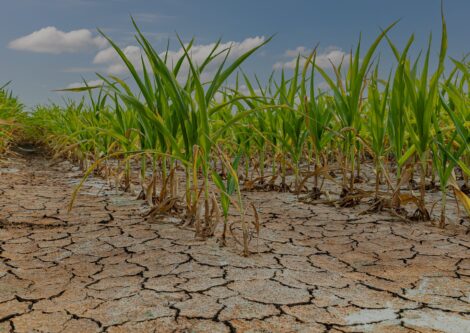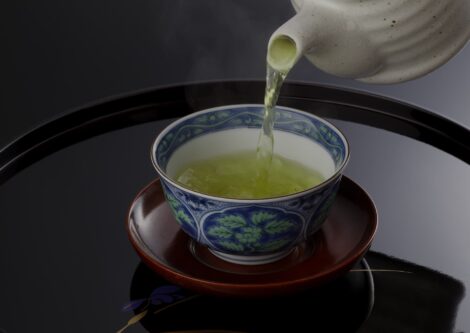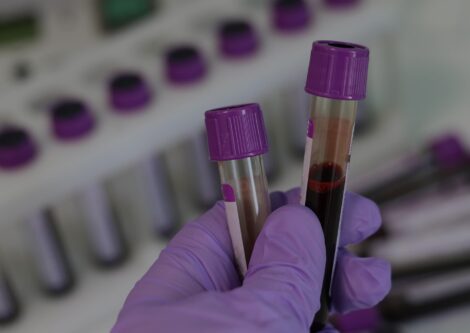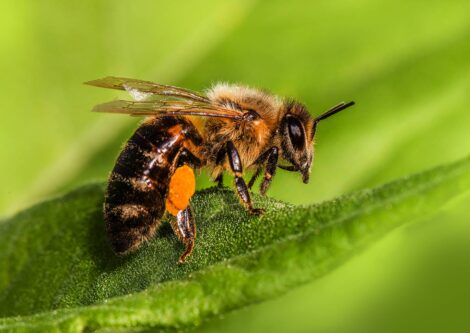The growth of paddy rice is affected by meteorological phenomena. Both 2023 and 2024 have seen high temperatures of a kind expected to occur just once in 30 years, resulting in rice supply shortages that have been dubbed the Reiwa no kome sōdō (rice shortage), likening the situation to unrest caused by similar shortages in previous centuries. High temperatures caused by the effects of global warming are forecast to lead to further decline in both yield and quality in years to come. Combined with the impact of higher CO2 concentrations, which are also said to be a factor in global warming, it seems likely that the deterioration in yields and quality will become even more serious than conventional projections suggest. Response measures are, however, progressing, including the development of heat-tolerant rice cultivars, and efforts to shed light on climate change processes to facilitate accurate forecasting of growth and yield.
Special Feature 1 – Climate Change and Japanese Food Impacts of high temperatures and rising CO2 concentrations on paddy rice and adaptation measures in response
composition by Toshiko Mogi
Meteorology has a number of realms relating to specific fields, such as agrometeorology. Meteorological phenomena affect the growth of paddy rice —— the main form of rice grown in Japan —— and those effects ultimately extend to rice yield and quality. What is more, meteorological phenomena also indirectly affect agriculture. One such effect is the emergence of insect pests. Certain meteorological phenomena make insect pests more likely to emerge. For example, last summer we saw huge numbers of shield bugs appear across the country. They are pests that suck out nutrients from rice grains in the husks, turning them black and reducing the quality of the rice. In addition, when temperatures are high, as they were 2023 and 2024, heat stress on agricultural workers also increases. This affects the health of the workers, giving rise to concerns about heatstroke, and may also reduce their work efficiency. These indirect impacts, too, are connected to yield and quality.
My research focuses on unraveling the impacts on Japanese paddy rice farming (rice production) of climate change due to global warming, as well as forecasting future impacts. The time frame of these forecasts is not the immediate term, such as this year or this season. Rather, my research centers on longer-range forecasting, examining what Japanese rice yield and quality will look like around the middle of this century.
| Name | Time frame |
| Short-range weather | Atmospheric conditions from the current moment to 2–3 days ahead |
|---|---|
| Long-range weather | Atmospheric conditions between a few days and a few weeks ahead |
| Climate | The overall condition of the atmosphere observed over decades |
| Meteorological phenomena | The overall term for atmospheric conditions and phenomena occurring in the atmosphere |
A temperature rise of more than 3°C above current levels will reduce yield
Based on previous studies, it is projected that, apart from in the north of the country, the yield from rice production in Japan will fall if global warming causes temperatures to rise by more than 3°C above current levels. Without adaptation measures, the risk posed by high temperatures to rice quality nationwide is also forecast to result in a decline in the ratio of first-grade rice.
Let us first briefly discuss paddy rice cultivation. In spring, farmers till the soil. Next, they fill the paddies with water and mix the water and soil together. The water used for this process is the runoff produced when snow melts in spring.
The timing of transplanting the rice seedlings into the paddies varies according to the region, but this process usually takes place in April or May. At the height of summer, the water is drained from the paddies, which are allowed to dry out until cracks form in the soil. The purpose of this midsummer drainage process is to replenish the oxygen in the soil, prevent root rot, and regulate the growth of the rice. However, recent research findings have shown that delaying drainage by a week makes it possible to reduce the volume of methane —— the GHG with the second-largest impact on global warming after CO2 —— generated by around 30%.
Depending on the variety and region, pale green spikelets (clusters of rice husks) begin to form on the rice stems sometime in August. This is called heading. As soon as heading takes place, flowers bloom on the spikelets. After flowering and pollination/fertilization, the rice enters the grain-filling stage, in which each individual grain on the spikelets grows bigger as it stores the starch produced by photosynthesis. Once the spikelets turn golden in color and their heads droop, they are at last ready to be harvested.
A key issue in the relationship between the projected rise in temperatures and fall in yield is the question of at what stage in the aforementioned cultivation process high temperatures affect the rice. One can see a higher tendency toward spikelet sterility than normal in paddies exposed to high temperatures during the heading and flowering period. Sterility is a phenomenon in which seeds do not bear fruit, due to the failure of fertilization —— in other words, it means that grains of rice do not form. Until now, a fall in rice yield due to high temperatures on a sufficiently large scale as to appear in statistical data has not occurred in Japan. However, there is a possibility that yield reductions due to frequent high-temperature sterility will become apparent in due course as warming escalates.
With regard to quality, an increase in chalky grains is thought likely. Chalky grains are grains of rice that have a cloudy white appearance (Figure 1). Their occurrence will increase because, at high temperatures, starch buildup via photosynthesis is inhibited and the grain-filling stage becomes shorter, which means that grain-filling ends before an adequate amount of starch has been built up.
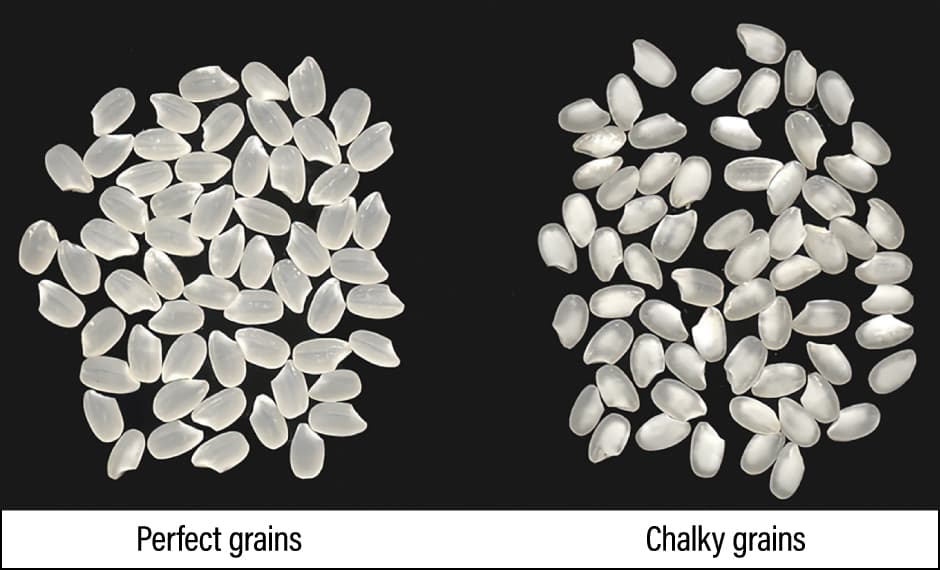 (Figure courtesy of NARO)
(Figure courtesy of NARO)
Figure 1. Comparison of perfect grains and chalky grainsRice grains that have developed into the proper shape are called perfect grains. Chalky grains are rice grains with a cloudy white appearance, due to insufficient starch buildup.
There have already been reports of chalky grains occurring in years with high temperatures and in certain regions. Most notably, last year’s record high temperatures resulted in phenomena including chalky grains being seen nationwide. The majority of consumers are unaware that rice is categorized into four grades: first-grade, second-grade, third-grade, and non-standard. The categorization is determined by visual inspection of the appearance of the brown rice. An increase in chalky grains will reduce the grading of the rice, causing its distribution price to fall as well. This would deal a blow to commercial farms.
The avoidance approach and the tolerance-enhancing approach
Ways of addressing the impacts of high temperatures can be broadly divided into two categories. The first is the approach of avoiding the exposure of crops to high temperatures. The second is enhancing crops’ tolerance to high temperatures.
The first category involves curbing the decline in quality by avoiding high temperatures during the grain-filling stage —— in other words, minimizing the occurrence of chalky grains. Chalky grains result from exposure to high temperatures during the first 20 days or so after heading —— the first half of the grain-filling stage. Accordingly, in regions where the grain-filling stage is prone to coincide with high temperatures under the current cultivation schedule, it is conceivable that approaches based on ensuring that high temperatures are avoided during the grain-filling stage would be effective. These could include later transplantation (shifting the timing when seedlings are transplanted into the paddies until a later stage), delaying development by planting seeds directly into the paddies, and introducing varieties with different maturation dates.
Efforts to popularize later transplantation are already underway in numerous regions as a comparatively low-cost adaptation measures, and the effects are being verified. Conversely, in relatively temperate regions, bringing forward the transplantation schedule would avoid not only high temperatures during the grain-filling stage, but also the typhoon season, which tends to coincide with the harvest period. It would also have the advantage of enabling farmers to ship new rice to markets ahead of other production areas.
However, meteorological phenomena fluctuate. The kind of high-precision forecasting that would enable us to state categorically that temperatures this year will be high is not possible at this point. Determining the timing of transplantation is therefore tricky. Given these circumstances, there is a palliative method that involves filling the rice paddies with cold water once temperatures get high, in order to lower the temperature of the rice plants themselves.
The second category, which involves enhancing crops’ tolerance to high temperatures, takes in the approach of increasing the heat tolerance of rice by means of appropriate soil and water management, fertilization, and weed and pest eradication, as well as the approach of developing and introducing heat-tolerant cultivars. Diligent efforts by front-line producers to increase heat tolerance via agricultural technology are already underway.
In addition, a number of cultivars offering both heat tolerance and high palatability have already been developed and launched as new rice brands. Readers may already have seen or even purchased varieties such as Kinumusume, Koshiibuki, and Tsuyahime in the shops (Table 2). Looking at data released annually by the Ministry of Agriculture, Forestry and Fisheries (MAFF), too, the area of land planted with heat-tolerant varieties is on the rise, so it would be fair to say that they are becoming increasingly popular.
| Cultivar name | Area planted (ha) (2022 growing year) |
Top 3 prefectures by planting |
| Kinumusume | 22,656 | Shimane, Okayama, Tottori |
| Koshiibuki | 19,600 | Niigata |
| Tsuyahime | 17,303 | Yamagata, Miyagi, Shimane |
| Fusakogane | 11,900 | Chiba |
| Akisakari | 7,658 | Hiroshima, Tokushima, Fukui |
| Nikomaru | 7,495 | Nagasaki, Shizuoka, Okayama |
| Tochigi no Hoshi | 7,200 | Tochigi |
| Sai no Kizuna | 6,500 | Saitama |
| Genki Tsukushi | 6,170 | Fukuoka |
| Sagabiyori | 6,060 | Saga |
| Yukinkomai | 5,200 | Niigata |
| Fusaotome | 4,800 | Chiba |
| Natsuhonoka | 4,058 | Nagasaki, Oita, Kagoshima |
| Shinnosuke | 4,000 | Niigata |
| Yukiwakamaru | 4,000 | Yamagata |
| Tentakaku | 3,802 | Toyama |
| Other | 21,185 | |
| Total 159,587 |
- *1 Heat-tolerant cultivars are varieties of rice that are resistant to reductions in brown rice quality and yield even at high temperatures. Figures for the area of land where these varieties have been introduced for the purpose of adapting to the impact of global warming have been compiled from reports by prefectural governments.
- *2 Figures for area planted include estimates.
High CO2 concentrations increase the proportion of chalky grains
CO2 is one of a number of GHGs that cause global warming. If CO2 concentrations rise, the greenhouse effect increases, elevating temperatures.
In the course of their growth, plants absorb CO2 in the atmosphere by means of photosynthesis. This is called the CO2 fertilization effect: scientists have long known that CO2 has the effect of increasing plant growth and yield in a similar way to fertilizers, because photosynthesis in plants thrives when atmospheric CO2 concentrations are high. However, it has become apparent that, if the temperature is too high, there is hardly any CO2 fertilization effect.
At NARO, assorted environmental control experiments are being carried out to shed light on the response characteristics of crops in expected future cultivation environments. Between 1998 and 2018, we conducted an experiment at two sites, in Iwate Prefecture and Ibaraki Prefecture, in which paddy rice was cultivated outdoors in environments managed in such a way as to provide a CO2 concentration of around 580 ppm, which is 200 ppm higher than at present (Figure 2).
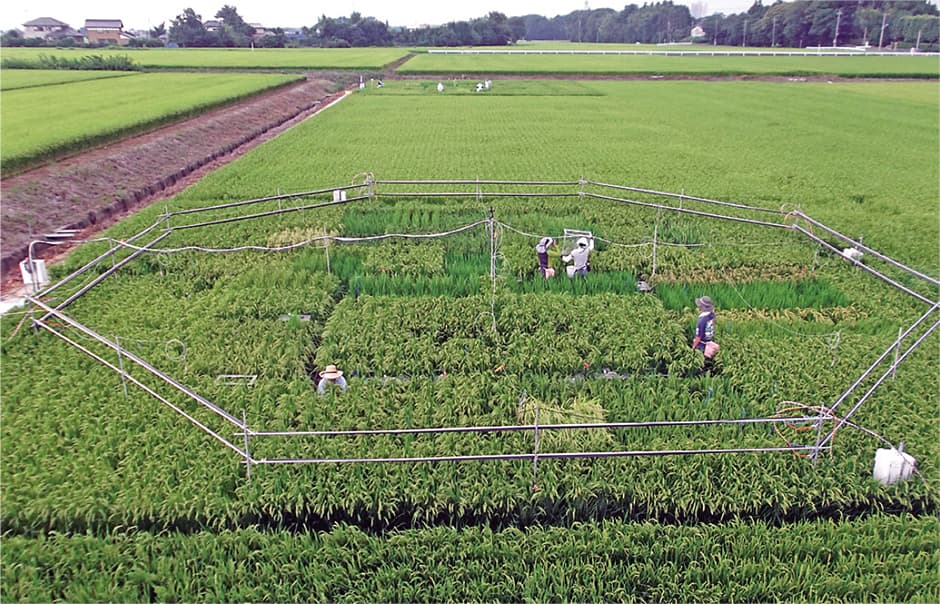 (Figure courtesy of NARO)
(Figure courtesy of NARO)
Figure 2. Free-Air CO2 Enrichment (FACE) ExperimentNARO scientists conducted an experiment in outdoor rice paddies, in order to shed light on the physiological response characteristics of paddy rice in high- CO2 environments of the kind envisaged likely in the future.
From the experiment, we found that the increase in paddy rice yield resulting from the CO2 fertilization effect declines when the rice is exposed to high temperatures, even if the CO2 concentration is high, and that high CO2 concentrations increase the proportion of chalky grains.
Why is there no CO2 fertilization effect? If the CO2 concentration increases when the temperature is high, plants undergo a physiological reaction that closes their stomata. The phenomenon whereby moisture is discharged from within a plant into the air mainly via the stomata is called transpiration; if a plant’s stomata close, the level of transpiration decreases. When this happens, the plant’s temperature rises. In other words, the plant goes into a state something like heatstroke. The physiological response by paddy rice to a growing environment of this kind is thought likely to lead to a decline in yield.
Based on the results of the same experiment, we have built a model that takes into account the combined effects of high temperatures and high CO2 concentrations in predicting paddy rice growth and yield, and have used this to predict the impact of climate change on the yield and quality of paddy rice in Japan (Figure 3). As a result, we have discovered that the decline in yield and quality will occur sooner and be more serious than predictions using existing models have suggested.
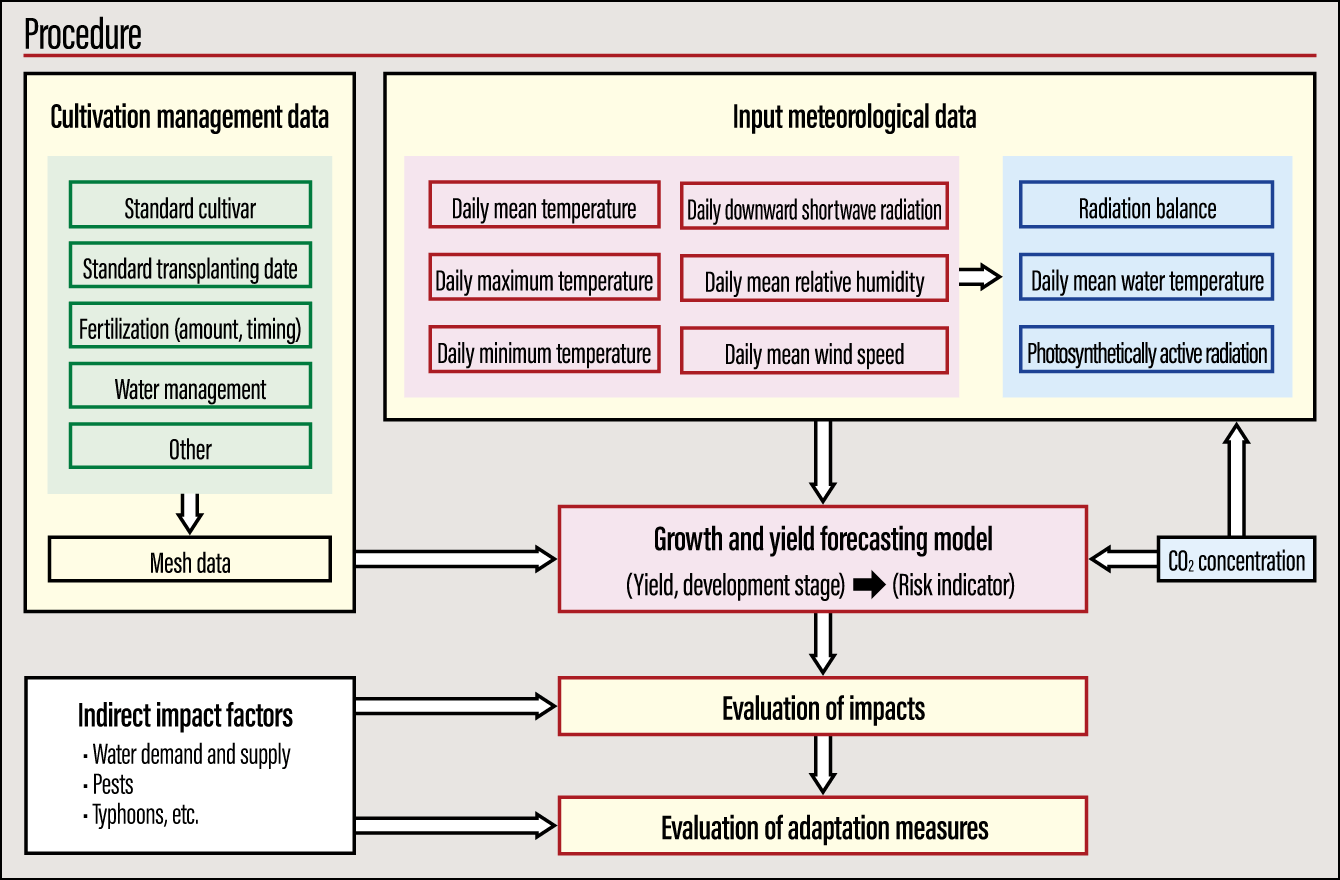 (Figure courtesy of NARO)
(Figure courtesy of NARO)
Figure 3. Forecasting models and evaluation of adaptation measuresScientists have used cultivation management and meteorological data to build a model that forecasts growth and yield. They are using this model to evaluate both impacts and appropriate adaptation measures.
With regard to yield, it had been thought that increased yield caused by high CO2 concentrations would be able to make up for decreasing yields due to the shorter growth period and increased sterility brought about by high temperatures. However, under conditions of both high temperatures and high CO2 concentrations, we cannot expect the effects to cancel each other out in this way. Accordingly, even some areas that were deemed likely to see increased yield under the conventional model feature prominently in the new model as areas that will experience a decrease in yield.
One should note that these findings reflect the results of experiments using existing widely used rice cultivars that are not very heat-tolerant. It will likely be possible to mitigate the harm by applying agricultural technology of the kind described in the previous section, adopting heat-tolerant cultivars that are in the process of being introduced and popularized, and delaying seedling transplantation to avoid exposing the rice plants to high temperatures during the grain-filling stage.
In addition, under the Climate Change Adaptation Act that entered into force in 2018, climate change adaptation plans are meant to be reviewed every five years, to ensure an appropriate response to forecast climate change. It is hoped that the national government and local governments will use the various results from experiments as key basic information when drawing up adaptation plans in accordance with the Climate Change Adaptation Act. Furthermore, one hopes that we will see the development of new, even more highly effective heat-tolerant cultivars, along with the development and widespread adoption of effective labor-saving cultivation technologies.
Global warming response measures that also take low temperatures into account
As you are well aware, GHGs emitted as a result of human activities are causing global warming, which is leading to climate change as it escalates. Changes in the climate will have major effects —— both direct and indirect —— on the growth of the crops that provide our food. Accordingly, around the end of the 20th century, scientists started working on projections of the impact of global warming-induced climate change on crops.
NARO has also, for some time, disseminated information in the form of various projection data concerning the impact on crop growth of climate change associated with global warming and the like. However, everyone who received this information regarded it as no more than a prediction that might possibly happen in the distant future. A key turning point that substantially altered this perception was the very hot summer of 2010.
Japan experienced a heat wave between June and August 2010. The average temperature that summer was around 2°C higher than the summer average at that time, reaching the highest temperature on record since observations began 113 years earlier. Various abnormalities —— adverse effects —— appeared in paddy rice, as well.
In fact, until that point, higher temperatures had been a positive factor leading to bumper harvests in northern Japan in particular. Based on the region’s history of rice crops being damaged by cold summers, farmers had thought that the higher the temperature, the higher the rice yield would be. However, the yield in northern Japan was not as high that year as had been anticipated.
Even northern Japan did not see any advantages from the higher temperatures, while other regions suffered negative effects in the form of a major fall in the ratio of first-grade rice. It would be fair to say that this gave rise to the awareness that projections of the impact of global warming on paddy rice cultivation were not virtual simulations, but something that could actually come to pass.
In this article, I have mainly discussed the impacts of high temperatures and high CO2 concentrations on paddy rice cultivation. Temperatures will likely rise as global warming escalates. However, one cannot say just because of this that damage due to cool temperatures will not occur.
Global warming is a phenomenon in which average temperatures rise over the long term, but it is not the case that temperatures will increase in every part of the world in exactly the same way. Rather, extreme weather events are likely to become frequent occurrences, with some regions suffering not only high temperatures and heat waves, but also extreme cold snaps.
As stated above, high temperatures speed up the growth of paddy rice, but low temperatures during the growth stage cause damage due to delayed growth, while low temperatures during the grain filling stage cause damage due to the failure of grains to develop properly. Going forward, I believe we should formulate measures to address climate change that take into account not only high temperatures, but also low ones.







